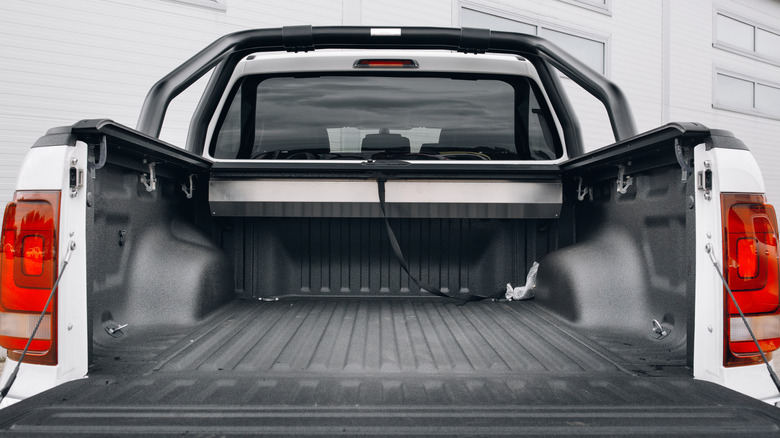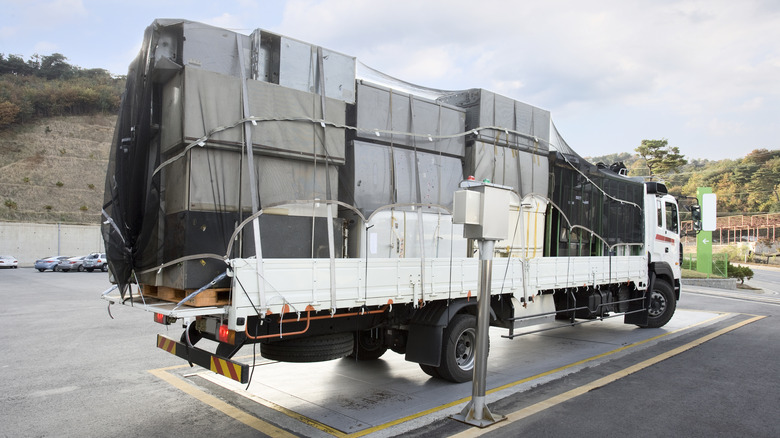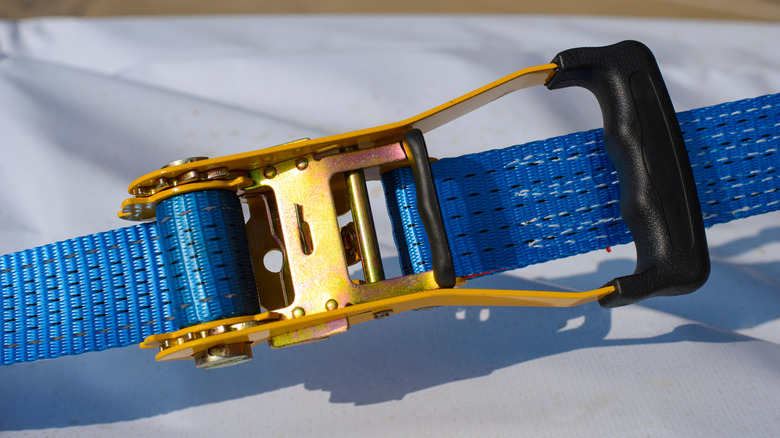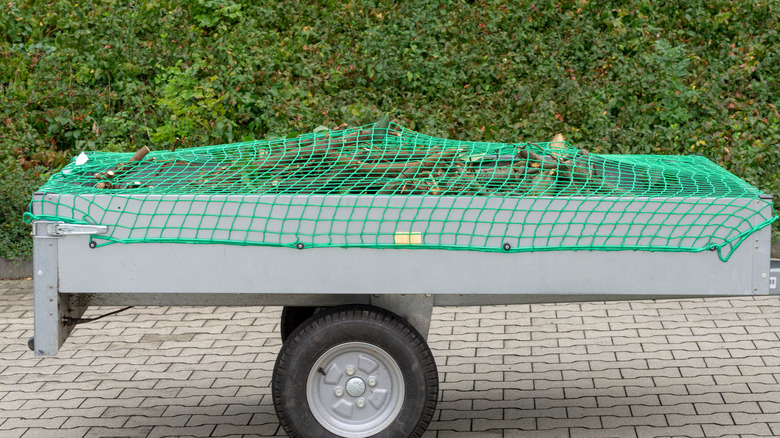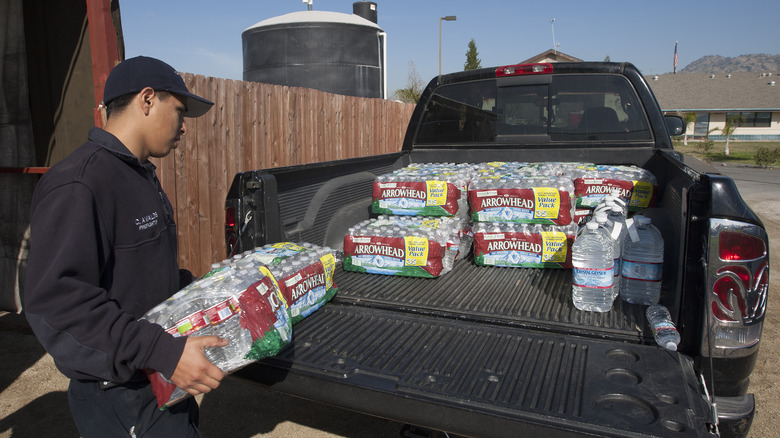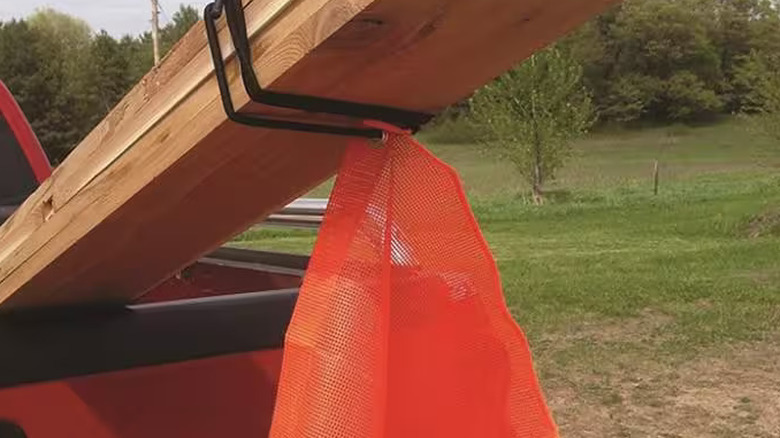5 Truck Bed Tie-Down Tips And Tricks You Need To Know
One of the most attractive reasons to own a pickup truck over a regular car is its hauling potential. The additional space that comes with having an open bed instead of a closed trunk gives you the ability to haul all kinds of small to mid-sized objects and loads, which makes it great for jobs like construction transportation, short-distance moves, and deliveries.
However, there is one disadvantage to an open bed that you don't get with a closed trunk: A single bump could send your precious cargo flying over the side and onto the road. Obviously, this is unfortunate for your load, but it could also create some serious safety hazards for you and other drivers. This is why no matter what you're hauling in your pickup truck, you need to carefully consider a variety of factors to ensure your load stays balanced and secured in the bed.
Double-check your capacity
The first and foremost step in the hauling process, before you can even load your cargo, is determining how much weight the bed can actually handle. Hearty though they may be, pickup trucks aren't superheroes. If you load too much cargo into the bed, you could throw off the vehicle's entire equilibrium, assuming it can even get moving in the first place.
Every truck has a GVWR — or gross vehicle weight rating — that determines how much extra weight it can realistically handle while still being safe to drive. You can find your truck's GVWR if you check the little safety compliance label on the driver's side door lock. For a clearer estimate of hauling capacity, visit a truck weighing station and weigh your vehicle while sitting inside it. Subtract whatever weight you get from the scale from your GVWR rating, and you have a standalone statistic for how much your cargo can safely weigh.
Use the right tools
To properly secure your cargo to your truck bed, you need the right equipment. You may consider attaching things like regular rope or bungee cords to your truck's anchors, but this isn't a good idea. Rope and bungee cords can't handle a lot of extra stress, so unless you're driving very slowly over perfectly level terrain, they are safe options.
Instead, you're going to want heavy-duty ratchet tie-downs, metal chains, and cargo nets. Ratchet tie-downs in particular are the bedrock of safe hauling — they attach to your truck's anchors and tighten over your cargo with reinforced ratchets to ensure nothing slips past them. Chains work more or less the same way but are better for large loads that really need to stay secured, like small vehicles. Cargo nets are ideal for hauling lots of small objects, as the mesh netting keeps little bits from flying away. All three of these tools should be used in concert to keep your cargo tied down and secured. Remember: No matter how small your load is, it should always be secured with at least one of these devices.
Group it up, pack it tight
If you're hauling a collection of individual objects, especially heavy things like wooden boards, you don't want them to be loose and flapping all over the place. If you've got a pack of slats in your truck bed, every bounce and jostle on the road will send them knocking against each other. Not only is this kind of annoying, but if they keep bouncing off of each other, they could loosen their bindings or damage each other, not to mention scuff your bed liner.
If you've got a bunch of objects in the bed, try to group them up together, then pack them up tight. Bundling a bunch of loose boards into a single, sturdy rectangle will keep them steady and prevent them from jostling each other or the truck. You can do this with some stretch wrap from the hardware store, supplemented by ratchet tie-downs. If the objects you're hauling don't easily fit together, use stretch wrap and a cargo net to wrap them all up into a cohesive whole. It doesn't have to look pretty — you're going to take it apart when you get to your destination.
Balance the load
Even if your cargo is effectively secured to your truck bed, it can still cause its share of problems if it hasn't been placed carefully. For example, if you were to tie a stack of cinder blocks to the right side of the bed, with nothing else on the other side, then your truck will start leaning to the right while in motion. This is both dangerous and rough on the suspension, so make sure your load is carefully balanced.
Try to spread your cargo equally across all sides of the bed — left, right, forward, and backward — placing heavy objects as close to the cabin of the truck as possible so they don't weigh down the rear wheels. You want roughly the same amount of weight across the bed so your truck doesn't pull in any one direction over the others. You should also tie down any heavy objects from both sides of the bed so they don't fall over in either direction.
Flag hefty loads
If you're hauling any especially large loads, particularly ones that are poking out of the bed, you need to inform everyone around you that you've got potentially hazardous objects on board. No matter how confident you are in your tie-down job, you never know when a random disaster might strike, so it's on you to ensure that any drivers behind you are aware of the possible danger.
The best way to do this is to attach a cargo flag. You can pick up a pack of these distinctive red flags from your local Home Depot, then attach them to any errant bits of cargo with industrial staples, bungee cords, or twine. Using a red cargo flag is actually required by law by both the U.S. Department of Transportation and most state governments — if you don't have a flag attached to any obviously protruding loads, that's grounds for a ticket. Keep the road safe and your record clean and attach that flag.
